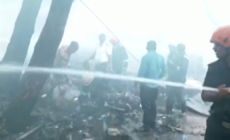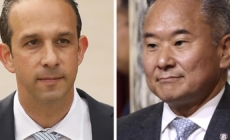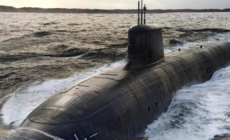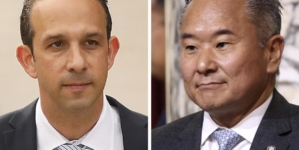-
Alexi Lalas on Pulisic sitting out Gold Cup, Pochettino’s failures, World Cup expectations | FULL EPISODE | The Herd - 15 mins ago
-
Eerie silence hangs over Central Coast farm fields in wake of ICE raids - 23 mins ago
-
California governor orders an investigation into the mystery surcharge on gas - 27 mins ago
-
Air India flight crashes shortly after take-off in Ahmedabad, India - 31 mins ago
-
Tenniix AI tennis robot offers reliable practice partner for all skill levels - 44 mins ago
-
Black Cat’s Unexpected Hiding Place Leaves Internet in Stitches - 48 mins ago
-
South Korean Battery Manufacturer Opens State-of-the-Art R&D Center in Göd - 51 mins ago
-
A reality check for the USMNT: Why Poch’s plan backfired in an ugly loss - 58 mins ago
-
L.A. Councilmember Lee breaks silence on infamous Vegas trip, ethics allegations - about 1 hour ago
-
FDA proposes “black-box warning” for breast implants - about 1 hour ago
Marines on streets of L.A. bring peril, questions
After days of fiery protest against federal immigration raids, Los Angeles residents and officials braced for the arrival of hundreds of U.S. Marines on Tuesday in what some called an unprecedented and potentially explosive deployment of active-duty troops with hazy mission objectives.
As Trump administration officials vowed to crack down on “rioters, looters and thugs,” state local officials decried the mobilization of 700 troops from the Marine Corps Air Ground Combat Center in Twentynine Palms, calling it a clear violation of law and civility. L.A. Mayor Karen Bass even likened the deployment to “an experiment” that nobody asked to be a part of.
According to the U.S. Northern Command, which oversees troops based in the United States, the Marines will join “seamlessly” with National Guard troops under “Task Force 51” — the military’s designation of the Los Angeles forces.
Air Force Gen. Gregory Guillot told The Times on Tuesday that the troops are in Los Angeles only to defend federal property and federal personnel and do not have arrest power.
“They are not law enforcement officers, and they do not have the authority to make arrests,” Guillot said. “There are very unique situations where they could detain someone if detaining was necessary to defend, but they could only detain that person long enough to hand it off to a proper law enforcement official.”
“We’re very highly trained, professional and disciplined,” he said.
But military experts have raised practical concerns about the unclear parameters of the Marines’ objective. They also warn that sending in Marines without a request from a governor — a highly unusual step that has not been made since the civil rights erain 1965 — could potentially inflame the situation.
U.S. Marines are trained for overseas conflict zones, with deployments in recent decades in Iraq, Syria and Afghanistan. But the roles they play in those nations — including providing artillery support to coalition forces fighting against Islamic State militants and advising and training local security forces in Afghanistan — are quite different from what they might face as they confront American protesters in Los Angeles.
“Marines are trained to fight, that’s the first thing they’re trained to do,” said Jennifer Kavanagh, director of military analysis at Defense Priorities, a military research group. “So I think you do have a little bit of mismatch in skills here….
“In a crisis, when they’re forced to make a snap decision, do they have enough training and experience to make the one that de-escalates the situation rather than escalates it? I think that’s a question mark.”
President Trump told U.S. Army troops at Ft. Bragg in North Carolina on Tuesday — hours after Defense Secretary Pete Hegseth told congressional lawmakers that the mobilization of troops to Los Angeles to curtail protests would cost $134 million — that he deployed thousands of National Guard troops and hundreds of Marines “to protect federal law enforcement from the attacks of a vicious and violent mob.”
But city and state officials have repeatedly said that troops are not necessary to contain the protests.
On Monday night, California Gov. Gavin Newsom called the deployment of Marines “a blatant abuse of power” and filed a lawsuit seeking to overturn the deployment.
Los Angeles Police Chief Jim McDonnell warned that — “absent clear coordination” — the prospect of Marines descending on Los Angeles “presents a significant logistical and operational challenge for those of us charged with safeguarding this city.”
It remains unclear exactly when and where Marines would arrive in Los Angeles.
By Tuesday afternoon, a convoy of Marine vehicles from Twentynine Palms had arrived at Orange County’s Naval Weapons Station Seal Beach under police escort.
“The Marines are on the base,” said Lt. Chris Hendrix of the Seal Beach Police Department. “That started last night.”
Northern Command confirmed only that members of the 2nd Battalion, 7th Marines had arrived in the Greater L.A. area, and declined to give specific information.
It is rare for U.S. Marines to be sent to an American city. The last time they were deployed in the U.S. was after riots broke out in Los Angeles in 1992 after the acquittal of four LAPD officers who were recorded beating a Black motorist, Rodney G. King.
Back then, President George H.W. Bush acted at the request of California Gov. Pete Wilson and Los Angeles Mayor Tom Bradley after what The Times described as “three days of the worst urban unrest in Los Angeles history.”
Deploying Marines to Los Angeles is not only a dramatic escalation of events, but also potentially illegal, according to Abigail Hall, a defense scholar and senior fellow at the Independent Institute, a nonprofit think tank based in Oakland.
Bringing in the Marines to L.A., she said, violates the Posse Comitatus Act, an 1878 law enacted after the Civil War, which forbids active-duty federal forces to provide regular civilian law enforcement unless authorized by Congress or the president invokes the Insurrection Act.
Trump has yet to invoke the Insurrection Act.
“I don’t see any way that this is not a direct violation of the Posse Comitatus Act,” Hall said. “We’re not at war, we’ve not invoked the Insurrection Act of 1807 — and even if we did, that’s what the National Guard is for. It’s not what the Marines are for.”
Gregory Magarian, a law professor at Washington University in St. Louis, said that deploying active-duty troops in a domestic law enforcement setting — without the request or even consent of the state and local officials — is “just another step down a very dangerous road.”
“What are they going to use these troops for?” Magarian asked. “In order to use the federal forces for law enforcement purposes, particularly the active-duty military, Trump would need to invoke the Insurrection Act. That’s the next big line in the sand. If he invokes the Insurrection Act, that’s worse. That’s a really huge problem.”
Kavanagh didn’t comment on the deployment’s legality but called it unprecedented in modern times, and worried that could make its mission and parameters unclear for troops.
The last time the military was deployed without a governor’s request or approval, military experts said, was to facilitate desegregation in Southern states during the civil rights movement in the 1960s.
Kori Schake, senior fellow and director of foreign and defense policy studies at the American Enterprise Institute, said the Trump administration appeared to be trying out a new way to get around the restrictions on domestic law enforcement by the American military.
“The authority the president is claiming is his constitutional authority under what’s called the Take Care clause … he’s claiming the federal responsibility to protect federal agents and federal property operations. That authority has never been tested in court.”
Such an approach, Schake said, was fraught with more than legal risk.
“If violence burgeons, tempers are running high, the Marines are armed, this could spiral out of control,” Schake said.
The L.A. deployment, Kavanagh said, could be a jarring mission for Marines who signed up to go abroad and defend America’s freedom — and instead are facing off with fellow citizens.
“Does everyone know the rules of engagement?” Kavanagh asked of the L.A. mission. “Are they clear?”
“Military personnel are generally trained to respond to crises abroad and they’re trained for offensive operations and engagement with the enemy, not necessarily crowd control or protest management,” Kavanagh said. “So it would seem to me that unless there’s a pressing need or a clear, demonstrated gap that local law enforcement can’t fill — which, from my understanding, is not the case — then this is not the time for any type of military force to be called in.”
Of all the military branches, the Marines retain the youngest service member on average due to the intense physical nature of the training. Nearly three-quarters of active-duty enlisted members of the Marine Corps are 25 or younger, according to a 2022 Department of Defense report. The average age is 24, compared with 27 for the Army and 28 for the Air Force.
Marines may be the youngest cohort in the military, Schake said, but they are also well trained in de-escalation tactics.
“The wars that the United States has been fighting for the last 25 years have required incredible discipline on the use of force by the military in Afghanistan and in Iraq in particular, so they are trained for de-escalating conflict,” Schake said. “I think actually, it’s quite possible they’re better trained at de-escalation of violence than the police forces are.”
Still, Schake said, she was less worried about violence than “creeping authoritarianism.”
“The way the president, that Homeland secretary, the secretary of Defense, the White House press spokesman are talking is incendiary and reckless,” Schake said.
“They’re calling the city of Los Angeles — where 1 in 40 Americans live — a hellscape, and everybody in the city a criminal. They’re describing protests that are really peaceful as an insurrection. And that’s a very reckless thing to do in a in a difficult situation.”
Times staff writers Hayley Smith and Christopher Buchanan contributed to this report.
Source link






























